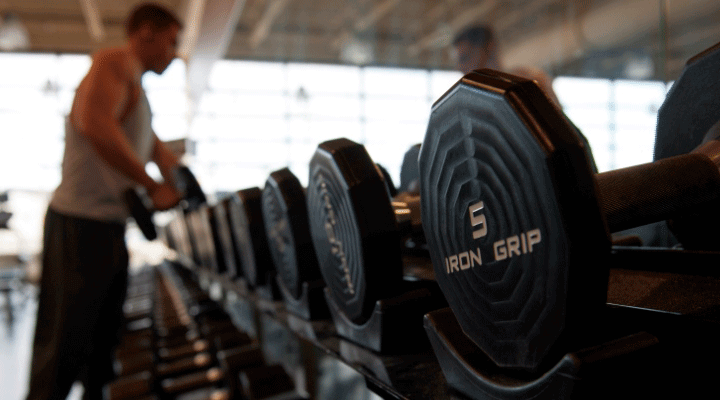Yes, sitting at your desk is killing you. Are you tired of hearing that? Let’s face it, if you read the news you know that everything is killing you, so why worry about your desk? It’s a very nice desk, after all, and you have a little tray for your paperclips and it has that nice little hutch where you can hide your bag lunch. But there are more reasons to get healthy at work than imminent death. Your health and your job performance are inextricably linked: healthy people make more money, are happier, and are more productive.
WHY GET HEALTHY
A study published in 2012 in the Journal of Labor Research reported that employees who exercise regularly “earn 9% higher pay on average than those who don’t.” Time notes that other studies have produced similar findings, though historically it’s been unclear as to whether exercise is coincidental to something more fundamental about successful workers, like punctiliousness, or general intelligence. This study isolated those other factors using something called “propensity-score matching,” and discovered that it’s the exercise that really matters to the equation. Want a raise? Buy running shoes.
It gets better. A study published in International Journal of Workplace Health Management found that workers who exercised before going into the office were happier and more relaxed. Seventy-two-percent, in fact, noticed improvements in time management on exercise days. (There is one caveat: on skip days, employees lost their sense of calm.) Meanwhile, the author of a paper in The Physician and Sportsmedicine found increases in productivity among the well-exercised ranks of the workforce. While the studies are not correlated, it stands to reason that a positive loop is in effect: relax, do better work, make more money, feel happier, relax, and so on—before you even consider the “live a longer, more active life” benefit of exercise.
WHAT TO DO
Health begins in the kitchen, which means that little hutch at your desk where you can stash you lunch is more important than you might think. (Maybe your desk isn’t killing you; maybe it can also keep you alive!) Instead of scarfing down all-you-can-eat bread sticks at Olive Garden every day, try brown bagging it. That doesn’t mean consignment to a life of sandwiches for lunch (though there are quite a few websites devoted to sandwich hacks). Recipes for healthy brownbag lunches are abound. WebMD offers several tips for packing healthy work lunches. This site has such marvels as the sweet potato, chickpea, and quinoa veggie burger (total calories: 356!) and spicy chicken chili (calories: 324). The food is surprisingly easy to prepare, and can’t possibly taste worse than the anemic, grease-laden, stale bread abominations handed out from drive-thru windows. (Don’t forget to check YouTube for great ideas.) Track your calories with such apps as MyFitnessPal or Lose It.
Getting your pulse rate up is going to require pounding pavement or lifting metal. With respect to running (and just ambulation in general), it’s hard to beat a fitness monitor such as a Jawbone or Fitbit. In addition to counting steps, reminding you to move, and tracking runs, there are great social features to let you get fit with friends, family, and coworkers. The American Psychological Association confirms that social support fosters weight loss. The National Library of Medicine agrees, and suggests that group exercise keeps things interesting, fun, and motivating. Note that if you get your exercise at the gym, beware of the “calories burned” readout on the cardio machines. The most accurate is the stationary bike. The worst at over-estimating the burn: the elliptical machine.
WebMD has advice on how to start a workout regimen. Manageable goals are key; attempting too much, too fast can lead to injury, obviously, but also disappointment and scheduling woes. Find something that works, and increase its intensity and duration over time.
HOW YOUR COMPANY CAN HELP (AND HOW IT BENEFITS THEM)
Your employer can help you get in shape. After all, a fit you means a better worker for them. Fitness benefits tend to come in three forms: on-site exercise facilities, gym membership discounts, and intramural sports.
Clearance holders often have an advantage with respect to fitness benefits. For example, the Department of Defense is the largest employer in the world, and their gym benefits are pretty well known. Large Defense facilities are likely to have access to several free, first rate fitness centers. (Ft. Bragg practically has as many gyms as chow halls.) Installation MWR offices can direct you to the best gym for your needs, or you can check out Yelp and Foursquare for the inside scoop.
In the private sector, it’s hard to compete with Boeing, whose facilities have had on-site fitness centers since the 1960’s. And the company goes much further than that, sponsoring an “industrial athlete program,” which provides everything from physical therapy and massage to stretching and conditioning exercises. (Because so much of what a Boeing worker might do is physical, the benefits to both employer and employee is obvious.)
Employers have a vested interest in getting you to the gym. Regular exercise makes you a more productive worker while simultaneously cutting down on health insurance costs. But remember: employee exercise benefits only work if you use them.
How does your employer encourage fitness? Let us know in the comments!




